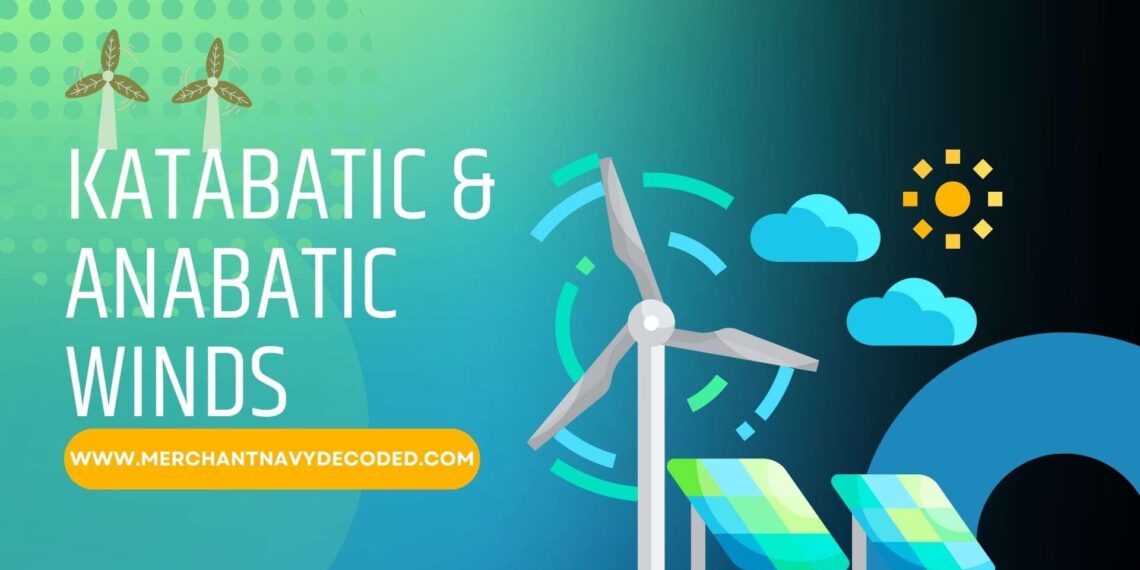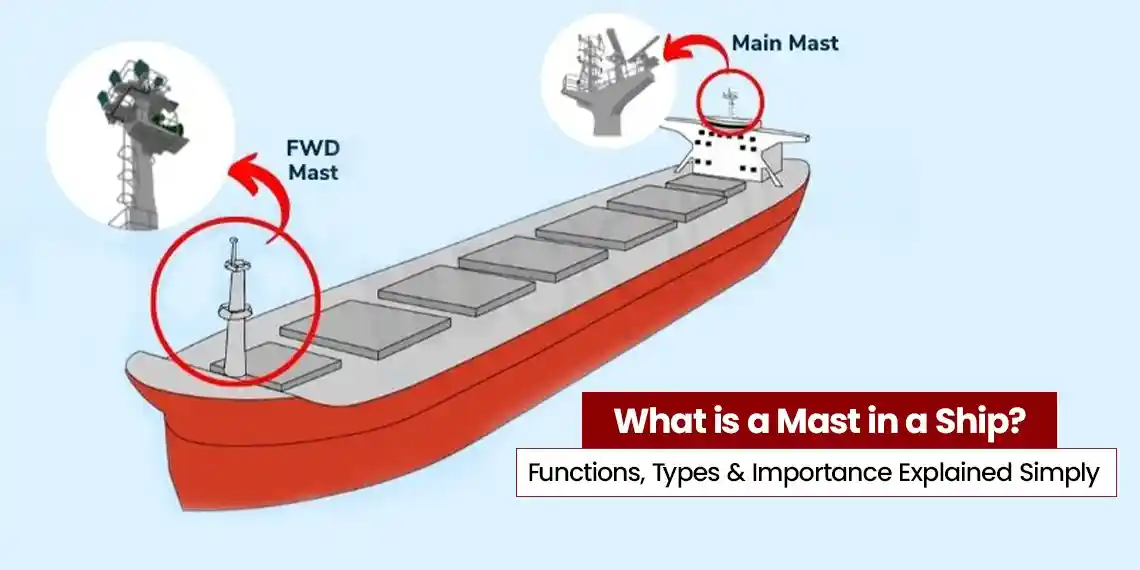What are Anabatic and Katabatic Wind
1:- Overview
- When I think of wind, I associate it with the calm, serene sea or the fierce thunderstorms, depending on my mood. We never really wonder how different these winds and their causes can be.
- Some of the most intriguing types of winds are the local winds; Katabatic and Anabatic Winds. They have a huge impact on weather patterns, climatic changes, and navigation, and hence, all Mariners should have a good understanding of such significant wind types.
- This blog will discuss the science behind such winds and why they are so important. We will also discuss the differences between Katabatic and Anabatic Winds and point out some of the major winds and their locations around the world.
2:- What are Katabatic Winds
The word ‘katabatic’ is derived from the Greek word ‘Katabatikos’, which means ‘descending’. Hence, these cold winds flow downhill in several mountainous regions due to differential heat loss which results in density differences of the air.
2.1:- Formation of Katabatic Winds


Let’s understand the science behind the formation of Katabatic Winds in simple points:
- They develop at night when there are clear skies as clear skies allow better radiational cooling.
- At night, due to rapid radiative cooling of land, the air adjacent to the slope (at point X) becomes cooler and hence denser than the air far away at the same level (at point Y)
- Under the force of gravity, this heavy & dense air rolls down the mountain slope towards the lower elevation due to the density difference.
- The slope gradient also plays a major role in the strength of such Katabatic Winds
- On reaching the foot of the slope, the wind moves out to the sea.
- As the wind flows downhill, adiabatic warming of the air is counteracted by constant conduction as the air is in continuous contact with the colder mountain slope.
- Adiabatic warming happens as there is no external heat energy in force. The internal compression causes heat.
2.2:- Factors Affecting Katabic Winds:
Several factors affect the formation of katabatic winds. Some of the major ones are listed below:
1. Topography:
The natural terrain heavily affects the katabatic winds. Steep slopes and valleys facilitate the downward flow of heavy and dense air
2. Radiational Cooling:
Clear skies allow efficient radiational cooling, leading to a significant drop in temperature and making the air denser and heavier.
3. Surface Characteristics:
The nature of the ground decides how quickly the air cools. A snow-covered mountain will cool faster.
4. Atmospheric Stability:
The stability of the atmosphere, often associated with high-pressure systems, aids in the formation of katabatic winds as stability ensures the cool air remains dense and doesn’t mix with warmer air below
5. Temperature Gradient:
A significant temperature difference between higher elevations and lower areas is necessary for the formation of katabatic winds. The greater the temperature gradient, the stronger the katabatic wind.
2.3:- Famous Examples of Katabatic Winds
As mentioned already, Katabatic winds are generally found in mountainous coastal areas. They are particularly found in Norwegian Fjords and ice-covered regions of Greenland and Antarctica.
Some of the most prominent and famous Katabatic winds are as follows:
- Mistral (France): It blows from the Alps down the Rhone Valley towards the Mediterranean Sea.
- Bora(Adriatic Sea): It is a North-easterly wind that descends from the mountains of the Eastern Adriatic Coat. It affects the coastal climate of countries like Croatia, Italy, and Slovenia.
- Santa Ana Winds (California, USA): Generally associated with warm and dry conditions, these winds can also be Katabatic when cool air from high desert flows into the coastal areas.

- Piteraq(Greenland): This katabatic wind flows down the Greenland ice sheet towards the coast.
- Oroshi: Blows down the Japanese Alps. It is particularly intense during the winter.
Effects of Katabatic Winds on Navigation:
Katabatic winds can become quite dangerous and hinder coastal navigation as they can become very strong. Especially when the slope is covered with ice or snow, minimal conduction takes place between the slope and the upper surface of the ice. The air is more rapidly cooled and hence, becomes very cold and dense. They can descend at speeds that can reach Gale Force (28-55 Knots)
3:- What are Anabatic Winds
The word ‘Anabatic’ comes from the Greek word ‘Anabatos’, which means ‘moving upward’. These are warm winds that blow uphill on a mountainous slope which is just the opposite of a katabatic wind. It is also known as an upslope flow.
3.1:- Formation of Anabatic Winds
Look at the diagram below and understand the science behind the formation of Anabatic winds.


- Anabatic winds develop during the day.
- The Source of heat is Solar Insolation. With clear skies, the slope absorbs Solar Radiation easily and the air that is in contact with it, (Point P) gets heated up.
- This heating results in a lower density than the air farther away at point Q.
- The air then moves up the slope and is subject to expansion and hence, cooling.
- The air maintains a continuous contact with the warm slope which ensures its continuous ascent.
- Maximum speeds are reached during the mid-afternoon
3.2:- Factors Affecting Anabatic Winds
The factors affecting both Anabatic and Katabatic winds are mostly similar. The slope of the mountain, clear skies, stable atmosphere, etc are some similar factors. However, the major factor contributing to the formation is the intensity of Solar Radiation.
3.3:- Famous Examples of Anabatic Winds
- Valley Breezes in the mountainous regions of the Alps, Rockies, and Andes are common examples of Anabatic winds.
- Scottish Highlands: Highland Breezes are forms of Anabatic Winds that are experienced in the Scottish Highlands.
- Himalayan Anabatic WInds: In the Himalayan region of India and Nepal, Anabatic winds are quite common during the day.
3.4:- Effects of Anabatic Winds on Navigation
They are much weaker than Katabatic winds and are of little relevance to the Mariners. They do not pose any significant danger to Navigation as they are mostly restricted to Land. However, they can lead to cloud formation and rain, especially in the afternoon.
4:- Difference Between Katabatic and Anabatic Winds
The following table provides a comprehensive comparison between the two winds:
| Characteristic | Katabatic Winds | Anabatic Winds |
| Direction of Flow | From Higher to Lower- Downward | From lower to higher- Upward |
| Time of Occurrence | Typically at Night or early morning | Typically during the day |
| Temperature | Cold Air | Warm Air |
| Driving Mechanism | Can lead to sudden drops in Temperature and strong winds | Buoyancy-driven, warm light air rises uphill |
| Associated Weather | This can lead to sudden drops in Temperature and strong winds | Can contribute to cloud formation and afternoon showers. |
Check out our other blogs on such amazing topics.
Disclaimer :- The opinions expressed in this article belong solely to the author and may not necessarily reflect those of Merchant Navy Decoded. We cannot guarantee the accuracy of the information provided and disclaim any responsibility for it. Data and visuals used are sourced from publicly available information and may not be authenticated by any regulatory body. Reviews and comments appearing on our blogs represent the opinions of individuals and do not necessarily reflect the views of Merchant Navy Decoded. We are not responsible for any loss or damage resulting from reliance on these reviews or comments.
Reproduction, copying, sharing, or use of the article or images in any form is strictly prohibited without prior permission from both the author and Merchant Navy Decoded.



